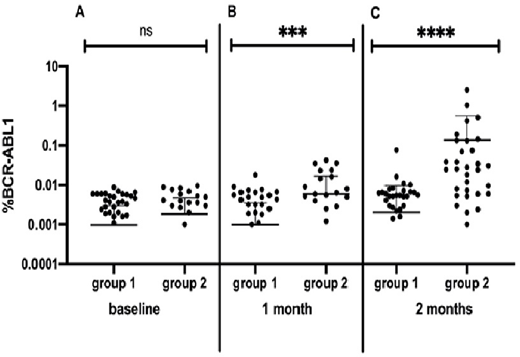
Introduction: the possibility to discontinue TKI therapy and maintaining molecular response, the so called "treatment-free remission" (TFR) has become common clinical practice and a goal of therapy in chronic myeloid leukemia (CML). It is now accepted to attempt TFR in patients with sustained deep molecular response (DMR) and resume therapy if major molecular response (MMR) is lost. The reported TFR rates range between 30% and 70%, but, at present, it remains difficult to identify factors that may predict TFR and, after TKI stop, to early detect patients who will eventually relapse. The present study was designed to evaluate BCR-ABL1 expression in patients attempting TFR, to investigate if baseline values and/or trends after TKI suspension could predict CML recurrence.
Methods: we analyzed the BCR-ABL1 RNA expression at therapy discontinuation (baseline), monthly during the first 6 months, bi-monthly between 6 and 12 months and three-monthly thereafter in 166 CML patients stopping imatinib (n=110) or 2nd generation TKI (n=56). Patients were divided among those who maintained MMR (group 1, n=120) and those who were deemed necessary to restart therapy for MMR loss (group 2, n=46). Molecular response was classified according to the standardized International Scale, DMR was defined as MR4 or deeper.
Results: median time from TKI stop and restart in group 2 was 5 months (range: 3-12). Mean BCR-ABL1 RNA expression at drug discontinuation for groups 1 and 2 was 0.0010±0.0020 and 0.0018±0.0029, respectively (p=0.052); difference in molecular response at stop did not reach statistical significance neither in the imatinib cohort (group 1: 0.0007±0.0019, group 2: 0.0016±0.0026; p=0.08) nor in the 2G-TKI one (group 1: 0.0015±0.0023, group 2: 0.0022±0.0032; p=0.64).
Mean BCR-ABL1 RNA levels one month after discontinuation were significantly higher in group 2 (0.0060±0.0107) than in group 1 (0.0010±0.0026; p=0.0005); this difference was confirmed and more evident two months after TKI stop as mean BCR-ABL1 value was 0.1354±0.4259 in group 2 compared to 0.0020±0.0076 in group 1 (p<0.0001) (Figure 1). The same trend was found in the imatinib group at month 1 (group 1: 0.0010±0.0028, group 2: 0.0059±0.0106; p=0.003) and at month 2 (group 1: 0.0021±0.0088, group 2: 0.0489±0.0913; p<0.0001) and in the 2G-TKI group at month 1 (group 1: 0.0009±0.0020, group 2: 0.0020±0.0037; p=0.014) and at month 2 (group 1: 0.0061±0.0113, group 2: 0.2707±0.6621; p=0.0001).
Moreover, even the slopes obtained with the values at baseline, one and two months (0.0006±0.0043 in group 1 vs 0.0237±0.0450 in group 2; p<0.0001) highlight the difference between patients with or without sustained MMR. These data were confirmed both for imatinib (-0.0043±0.0370 in group 1 vs 0.0237±0.0450 in group 2; p<0.0001) and for 2G-TKI (0.0002±0.0018 in group 1 vs 0.1132±0.3057 in group 2; p=0.0007).
For the determination of a threshold value of BCR-ABL1 RNA at one month after discontinuation, the ROC analysis was performed, defining an AUC=0.6430 (IC 95%: 0.5361-0.7498 p=0.0066): the cut-off value for BCR-ABL1 was defined as 0.0051%. The chosen range has 92.2% specificity, 31.7% sensitivity and a likelihood ratio of 4.087.
Conclusions: our data suggest that the chance of a successful TFR could be foreseen already at one month after TKI discontinuation, both for patients stopping imatinib or 2G-TKI. The 0.0051% BCR-ABL1 cut-off value identify patients who will maintain MMR; this could allow for a lengthening of molecular monitoring.
Krampera:Janssen: Membership on an entity's Board of Directors or advisory committees; Novartis: Membership on an entity's Board of Directors or advisory committees. Semenzato:Roche: Honoraria; Abbvie: Honoraria; Takeda: Honoraria.
Author notes
Asterisk with author names denotes non-ASH members.

This icon denotes a clinically relevant abstract


This feature is available to Subscribers Only
Sign In or Create an Account Close Modal